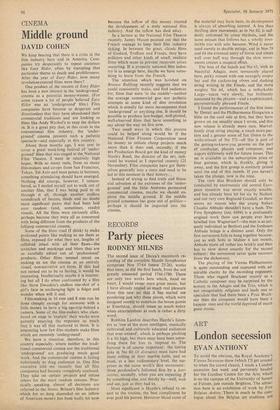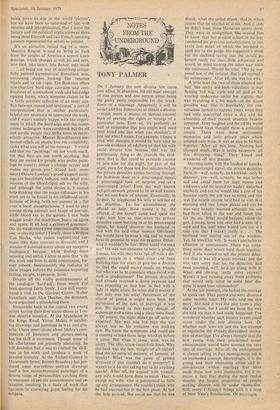ART
London secession
EVAN ANTHONY
To avoid the obvious, the Royal Academy's Vienna Secession show (which I'll get around 7 to when the crowd clears), I made a London ,secession last week and perversely headed for the Gardner Centre for the Arts, which is on the campus of the University of Sussex at Falmer, just outside Brighton. The attrac- tion here is an exhibition of work by Five Belgian Artists. There is much in the cata- logue about the Belgian art tradition not
being given its due in the world 'picture', but we have been so saturated of late with theories and interpretations, that I leave the history and the political implications of there being three Flemish and two French speaking painters represented for others to ponder.
It's an attractive mixed bag of a show. Maurice Roquet is said to 'bring us back from the jungles of America a superb kalei- doscope, which changes at will, his and ours, into bird, into insect, into flower, into mask
.', all being one way of describing colour- fully painted asymmetrical Rorschach tests, containing shapes looking like venetian blinds and/or rib cages. Jan Beekman offers non-objective hard-edge canvases and com- binations of watercolour wash and hard-edge opaque forms, which someone claims to be 'a fairly accurate reflection of an inner con- flict between reason and sentiment,' a sort of interpretation that• is neither particularly helpful nor necessary to appreciate the work, and I wasn't entirely happy with the experi- ment in which the hard-e,dge and the water- colour techniques were combined, but the oil and acrylic panels may strike some as decor- atively attractive. Marcel Broodthaers's em- bossed reliefs on plastic lose me completely; make what you will of his message : 'I would add that my "paintings" are not worth much, not that they arc not worth anything. But• they are meant for people who prefer paint- ings to money; unless a change occurs and makes my prices rise.' (Good luck, mon- sieur.) Octave Landuyt's grand-guignol paint- ings are beautifully hideous, with detail rem- iniscent of the fibre-fatigue ads on the telly, and although the artist denies it, I cannot help thinking that the major influences in his work are to be found in his childhood recol- lections of living 'with my parents in a flat over a local slaughterhouse. I used to play among dying animals and heaps of entrails, while blood ran in the gutters. I saw bulls stagger under the deathblow, heave up again and again. It all had a .primeval greatness'. (So do watch where your impressionable little one is playing today.) Finally, there isWillem Van Hecke, who paints sophisticated car- toons (like Klee married to Rouault) and I wonder if I should worry about my receptive inadequacy because, while finding them amusing and artful, I seem to miss that 'with this work one lives in daily communion, for- ever reborn. Inexhaustibly the radiance of these images follows the existence imparting feeling, insight, expression, form.'
Despite all the waffly pretentiousness of the catalogue 'hard-sell', from which I've been quoting fairly freely, I can still recom- mend a visit to the Gardner Centre. Walter Eysselinck and Alan Daiches, the directors, have organised a stimulating show.
Meanwhile back in the capital two young artists having their first major shows in Lon- don deserve mention. At the Mannheim in the Kings Road, Victor Mehra is exhibit- ing drawings and paintings in wax and gou- ache. I have reservations about Mehra's com- bination of literature and picture-making but his skill is enormous. Though some of his affectations are presently alienating, he will doubtless find a way to control the slick- ness in his work and produce a work of genuine intensity. At the Andsell Gallery in Monmouth Street, Robert Broadway has pro- duced some marvellous portrait drawings (and a few monochromatic paintings) of a diverse range of personalities, catching them in moments of private concentration and re- laxation, resulting in a body of work that succeeds in conveying great feeling for his subjects.











































 Previous page
Previous page